You know how everyone has at least one special talent that makes them unique? My special talent, to date, is having no special talent. So my life’s work has been a never ending exploration of the unknown, with the hope I would eventually stumble into something I could do well.
Welding? Could be the one!..!!
Research and due diligence on welding gear and equipment, led me to purchasing a hodgepodge of products. Yes, a hodgepodge, and mostly a Chinese hodgepodge at that.
I have not attempted welding since 1982, an effort that ended with a 1965 Mustang missing a left rear quarter panel, a smokey garage fire, a shirt sleeve fire and the local high school getting the car as a donation to their auto shop ambitions. Humble beginnings, yet, here we are again.
So far, I have opened and checked all of the boxes for contents, assembled what needed assembly and moved it all into the garage to the dismay of the tractor and its attachment brethren. Only the passage of time will again earn their trust.
I am now in the process of perusing equipment manuals. With each came 20 pages of warnings and cautions, the first category much more intense than the second, it is looking like going forward poses some minor risk.
60% chance of execution
37% chance of a house fire
81% chance of incidental laceration and third degree burns
92% chance of arc induced blindness
49% chance of project welded to the work table
50% chance of lungs falling out as a result of toxic fumes
2%-3% chance of project success
Oddly enough, those are nearly the same risk categories and potentials in my efforts to play electric guitar. Good times! So before any of those risks play out…
Preface comments..
For anyone who has worked on a manufacturing floor, spent time in a production machine shop, woodworking shop, made tooling or production related process equipment, what Ruger has accomplished with the revival of Marlin is impressive.
While Ruger has made many types of firearms, including the company’s Model 96 lever actions between 1996 and 2009, none laid exact groundwork for the Marlin products that now come out of Ruger’s Mayodan, NC facility.
The fact that Ruger was able to go from bidding on Marlin assets during Remington’s bankruptcy sale in October 2020, to shipping high grade product in less than a year, speaks volumes for Ruger’s depth of firearm making knowledge, talent and persistence.
The return of the Marlin Model 336
The Marlin Model 336 is… different than other reintroduced Marlins. No stainless steel, no laminated stock, no 45-70, no truncated barrel. The Model 336 was Marlin’s first closed receiver, round bolt design. The Model 336, parent to the current Model 1895, was originally a 1948 mid century introduction.
|
Marlin Model 336C |
|
| Origin | Mayodan, NC |
| Manufacturer | Ruger |
| Model | Marlin Model 336™ Classic |
| Type | Lever Action |
| Caliber | 30-30 WCF |
| Capacity | 6+1 |
| Barrel Length | 20.25″ |
| Rifling | 1:12″ 6 Groove RH |
| Nominal Weight | 7.5 lbs |
| Overall Length | 38.625″ |
| Stock | American Black Walnut |
| Hardware | Satin Blued Steel |
| Length of Pull | 13.38″ |
| Drop at comb | 1.25″ |
| Drop at heel | 2.00″ |
| Sights | Semi Buckhorn / Hooded Ramped |
| Scope | Drilled and Tapped |
| Trigger Pull | 5 lbs. 13 oz. |
| Safety | Cross Bolt |
| MSRP |
$1239.00 |
Where I grew up, New Jersey, teens saved for the Marlin Model 336 or Winchester Model 94 and traveled to Pennsylvania or New York State to deer hunt. New Jersey has been a shotgun only state for as long as I can remember. Two to one, young hunters went with the Marlin because of its closed top receiver and side eject. The closed, flat top receiver facilitated scope mounting and the side eject directed empties away from the shooter.
Wonder what those old Marlin 336s looked like?
Two inches and 66 years separate the two Model 336 Marlins pictured above. Top, my first owned centerfire rifle, a Christmas gift in 1956, a week after my twelfth birthday. I dry fired it so much, practicing trigger pull before I could get to the range, I broke the tip off the forward firing pin.
It looks good, if utilitarian, but that is the third stock refinish and a re-blue. The last refinish was done in an underground bunker, while on SAC B-52 nuclear alert pad duty… 1969 maybe? The re-blue was done by the old Marlin company maybe a year earlier.
Below it, an aesthetically superior version of the same, a current Marlin Model 336 Classic. My old gun was a Model 336c, a plain saddle carbine. The new Marlin has lots of process an refined part differences, such as: wider flairs at either end of the receiver for increases strength, A folding rear sight that moves out of the way of scope objective bells, a cross bolt safety, a slightly fuller buttstock and forearm that are a better fit for adult hands and checkering that remains non slip even in cold and wet weather.
The early Marlin has 1:10″ microgroove rifling. The new Marlin has a 1:12″ twist a Ballard type 6 groove rifling. Despite the old Marlin’s marketing hype, my old gun was not particularly accurate 2″ and under at 100 yards. which is not far off bolt action rifle performance of that day. I do not as yet know, conclusively, the accuracy of the new Marlin 336 Classic, but I will.
A nicer set of old time sights. The Marlin Model 336 Classic is fitted with the modern generation of semi-buckhorn sights and hooded, ramped brass bead front sight. Compared to my old 336, this rear leaf folds down, forward, to clear a scope’s objective lens bell. Adjustment for windage is done by drifting the sight in its mounting dovetail.
Where the old gun has a round domed hood, the modern version is flat topped and wider for a better, aligning, view of the front sight. The old rifle’s bead is spherical and polished, the more recent generations are flat faced and matte for a cleaner sight picture.
I’ve seen younger shooters grouse about semi-buckhorn sights as being imprecise. That little U notch aperture and round front bead is about as precise as it gets for people who take the time to understand them. I could be wrong, but 60+ years and lots of venison and feral hog hams suggest I am not.
Safety mechanisms and subsystems….
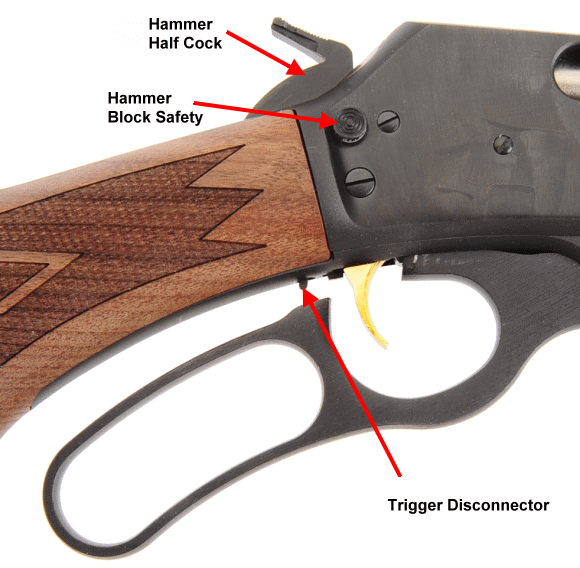
In 1984, Marlin discontinued the use of the half cock position as the rifle’s only manual safety, when a hammer blocking cross bolt safety was added. Passive safeties remained. A trigger disconnector prevents the trigger from being pulled until the lever is completely closed and compressing the disconnector. Ruger has carried forward all of these proven safety devices.
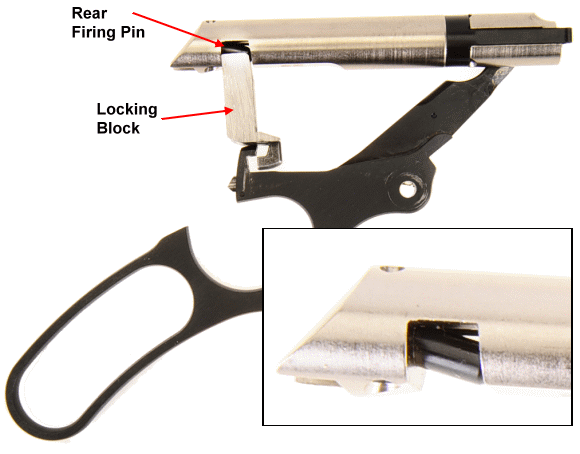
The Marlin 336 design utilizes a two piece firing pin, cleverly identified as rear firing pin and front firing pin. With the lever down, the rear firing pin is spring loaded down at an angle to prevent it from passing through the center of the bolt and driving the front firing pin into the primer of a chambered round. With the lever closed and the bolt pulled into battery, the locking block raises the rear firing pin into alignment with the front firing pin. In that alignment, when the hammer falls, the rear firing pin is driven into the front firing pin and into the primer of a chambered round.
Blasphemy.. Yeah, yeah.
If at all possible, I mount a scope on any firearm that will be shot 50 yards and farther during review. I don’t think anyone wants my eyesight to be representative of a firearm’s accuracy potential. That said, the Model 336 can easily mount a scope, rail, red dot sights, fiber optic sights, and peep sights.
Because Ruger kept receiver top hole spacing to the Marlin standard, first applied to the Model 336 in 1956, the accumulation of sight systems and mounting devices are all valid. The same applies to other aftermarket replacement parts and accessories.
30-30 WCF lethality
I have to laugh when I see someone say the 30-30 WCF is marginal for woodland deer hunting. I will guarantee that person never hunted with a 30-30 WCF, or is blaming a poorly placed shot on insufficient cartridge power.
Couple of things. Few deer are shot beyond 100 yards, many more beyond 50 yards, unless a hunter deliberately sets up to take a long shot. The reasons are conservative hunters, topography and trees; all get in the way of long shots. So long rang power concerns are ill founded. Additionally, a 30-30 WCF with standard jacketed soft point bullets tend to shoot through deer and hogs at close ranges, leaving an impressive exit wound.
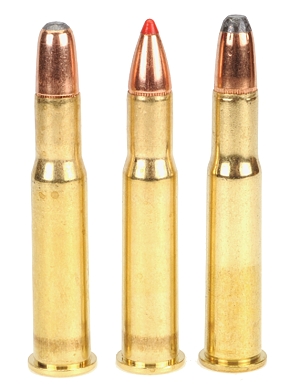 There are currently, approximately, 37 factory loads for the 30-30 WCF, an accumulation of 11 brands. Bullet weights range from 125 grains to 190 grains. Velocity is both supersonic and subsonic. Expanding bullets are offered in conventional lead core, jacketed types and solid copper.
There are currently, approximately, 37 factory loads for the 30-30 WCF, an accumulation of 11 brands. Bullet weights range from 125 grains to 190 grains. Velocity is both supersonic and subsonic. Expanding bullets are offered in conventional lead core, jacketed types and solid copper.
Pictured L-R:
Hornady American Whitetail 150 Gr 2390 FPS
Hornady LEVERevolution 160 Gr 2400 FPS
Winchester Power Point 170 Gr 2200 FPS
The LEVERevolution cartridge features a higher than typical ballistic coefficient 160 grain bullet, hard lead core and special polymer soft tip that can safely be loading into a tubular magazine without concern for accidental discharge. The other two utilize more conventional bonded, soft lead core jacked bullets.
Best zero performance…
The 30-30 WCF responds well to picking critical target size and best zero to stay within that target. In this case, Real Guns Ballistic Calculator target size was set at 6″, maximum range at 200 yards, which yielded an almost 200 yard point blank range… no hold over.
| Best Zero – Results Hornady American Whitetail | |||||||
| Near-Zero – yards. | 20 | Mid Range – yards. | 105 | ||||
| Far-Zero – yards. | 182 | Max Ordinate – “ | +3.0 | ||||
| Point Blank – yards. | 193 | ||||||
| Best Zero : Range 0 – 200 yards | ||||||||||||
| Yards | 0 | 50 | 100 | 150 | 200 | |||||||
| Velocity – fps | 2390 | 2169 | 1961 | 1765 | 1584 | |||||||
| Energy – ft.-lbs. | 1902 | 1567 | 1281 | 1038 | 835 | |||||||
| Momentum – lbs-sec | 51 | 46 | 42 | 38 | 34 | |||||||
| Path – “ | -1.50 | 1.66 | 2.97 | 2.01 | -1.76 | |||||||
| Drift – “ | 0.00 | 0.00 | 0.00 | 0.00 | 0.00 | |||||||
| Time Of Flight – sec. | 0.00 | 0.07 | 0.14 | 0.22 | 0.31 | |||||||
| Best Zero – Results Hornady LEVERevolution | |||||||
| Near-Zero – yards. | 21 | Mid Range – yards. | 114 | ||||
| Far-Zero – yards. | 201 | Max Ordinate – “ | +3.0 | ||||
| Point Blank – yards. | 214 | ||||||
| Best Zero : Range 0 – 200 yards | ||||||||||||
| Yards | 0 | 50 | 100 | 150 | 200 | |||||||
| Velocity – fps | 2400 | 2294 | 2191 | 2091 | 1994 | |||||||
| Energy – ft.-lbs. | 2046 | 1869 | 1705 | 1553 | 1412 | |||||||
| Momentum – lbs-sec | 55 | 52 | 50 | 48 | 46 | |||||||
| Path – “ | -1.50 | 1.54 | 2.92 | 2.50 | 0.09 | |||||||
| Drift – “ | 0.00 | 0.00 | 0.00 | 0.00 | 0.00 | |||||||
| Time Of Flight – sec. | 0.00 | 0.06 | 0.13 | 0.20 | 0.27 | |||||||
| Best Zero Results – Winchester Power Point | |||||||
| Near-Zero – yards. | 19 | Mid Range – yards. | 101 | ||||
| Far-Zero – yards. | 177 | Max Ordinate – “ | +3.0 | ||||
| Point Blank – yards. | 188 | ||||||
| Best Zero : Range 0 – 200 yards | ||||||||||||
| Yards | 0 | 50 | 100 | 150 | 200 | |||||||
| Velocity – fps | 2200 | 2047 | 1901 | 1762 | 1629 | |||||||
| Energy – ft.-lbs. | 1827 | 1582 | 1364 | 1171 | 1002 | |||||||
| Momentum – lbs-sec | 53 | 50 | 46 | 43 | 40 | |||||||
| Path – “ | -1.50 | 1.78 | 2.99 | 1.79 | -2.22 | |||||||
| Drift – “ | 0.00 | 0.00 | 0.00 | 0.00 | 0.00 | |||||||
| Time Of Flight – sec. | 0.00 | 0.07 | 0.15 | 0.23 | 0.32 | |||||||
Comparing the three factory locates indicated, regardless bullet weight and muzzle energy all are flat shooting out well beyond anticipated shooting distances. If all are considered to have appropriate bullet construction, the greatest benefit to one, the Hornady LeverEVOLUTION round provides meaningful increases in kinetic energy even at 50 yards.
Overall
 I am going to take a break here, with a week’s worth of accuracy and chronograph data collection ahead of me. So far the Marlin illustrates the degree of effort and restraint Ruger has invested in restoration of the Marlin brand.
I am going to take a break here, with a week’s worth of accuracy and chronograph data collection ahead of me. So far the Marlin illustrates the degree of effort and restraint Ruger has invested in restoration of the Marlin brand.
Poking around a bit, I was happy to find tools and fixtures, springs and aftermarket performance parts all still apply to this release. None of it is needed now as the action is smooth, as is fit an finish of parts.
The finish, both wood and metal is flawless. Not sharp edged loading gate, no uneven polishing or buffed off angular surfaces. The wood grain is clean, nice pieces of walnut. So lets see how it shoots for record.


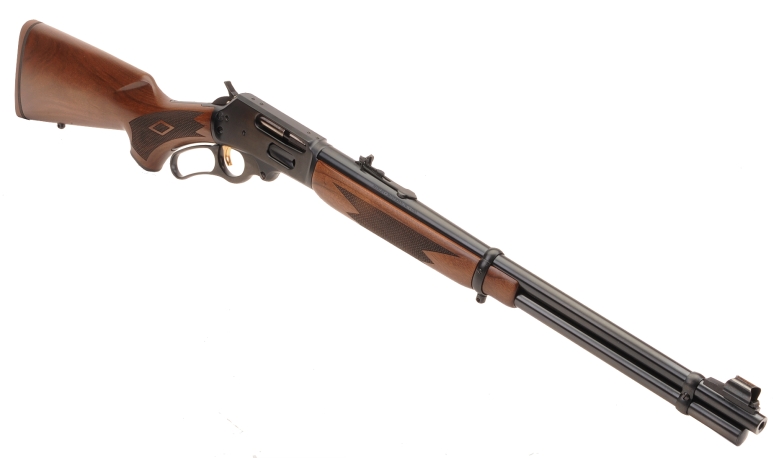

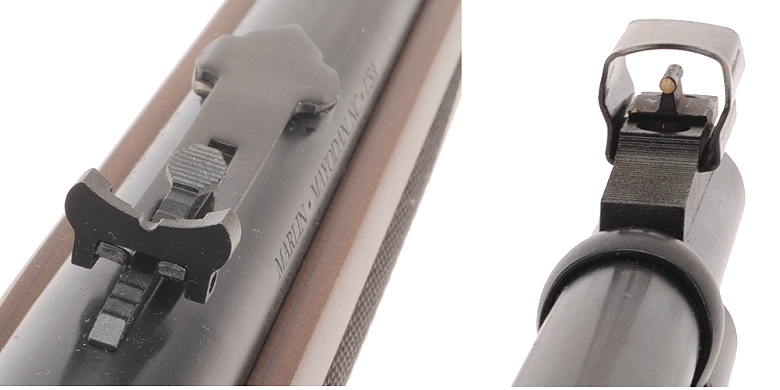
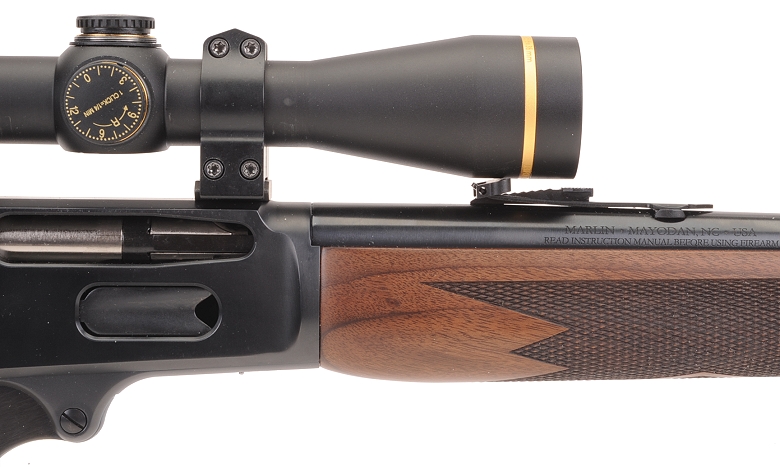
Email Notification